5 Winning Email Sequence Templates for 2023
Matthew Turner
Updated by Tara Malone
Is email marketing still relevant to your business? With the rise of social media and a younger audience that spends less time in their inbox, do you really need an automated email sequence?
The short answer is yes. Email marketing is still relevant for online businesses, and here are just a few of the reasons why:
- It’s estimated that for every $1 you spend on email marketing you get a return of $42.
- Email marketing is VERY cost-effective.
- Among professionals, email remains their preferred means of communication.
Although email marketing won’t automatically solve all your business problems, it’s tried and tested, low-cost, and easy to maintain. So if you have an online business, it’s definitely worth investing your time and energy on email marketing.
To help you get started, we’ve compiled 5 email sequence templates that can have a huge impact on your business. No matter what your business is, you can take any of these email sequence templates and make them work for you.
Let’s begin!
The Top 5 Email Sequences for 2023
There’s a good chance you can use at least some of the following email sequences in your email marketing strategy. Many online businesses need all five, as each one leads into the next.
It all begins with this first email sequence example, the one that lays the foundations for everything else.
Email Sequence Template 1: The Welcome Sequence
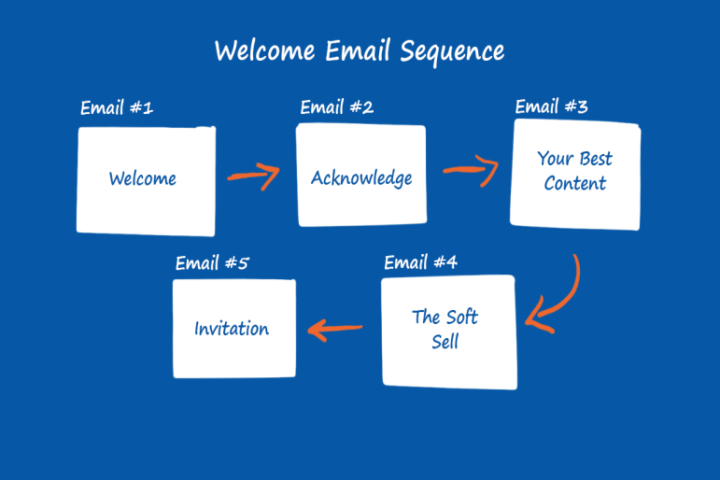
The Welcome Sequence is for someone who’s new to your business. For whatever reason, they have decided to take a chance on you and dive deeper into your world. Maybe they read a blog post, heard you on a podcast, came across you in a feature article, or found you while researching on Google.
At the this stage, it’s safe to presume they do not know you and you’ve yet to build their trust.
The purpose of the Welcome Email Sequence is to do just that – to lay the foundations for a long-term relationship.
Over a period of seven to ten days, you welcome them, get to know them, provide them instant value, and invite them to take the next step with you. How long your emails are and what they focus on largely depends on you and your business.
These are the emails we recommend you build your Welcome Sequence around:
Email 1: Welcome and Next Steps
This is the first email they receive from you, and it should land in their inbox immediately after they take action. The reason they get this email could be for a variety of reasons:
- They downloaded a guide…
- signed up for a trial…
- created a new account…
- joined your newsletter…
- wanted to learn more about your product…
You should create your first email around the action they took. But this is also a chance for you to make a positive first impression. It’s time to briefly introduce yourself, welcome them to the journey you plan to take them on, and make it clear what their next steps should be.
The 1-2-3 Method is a popular technique to ensure you achieve this.
Here’s an example of it in action from Asana.
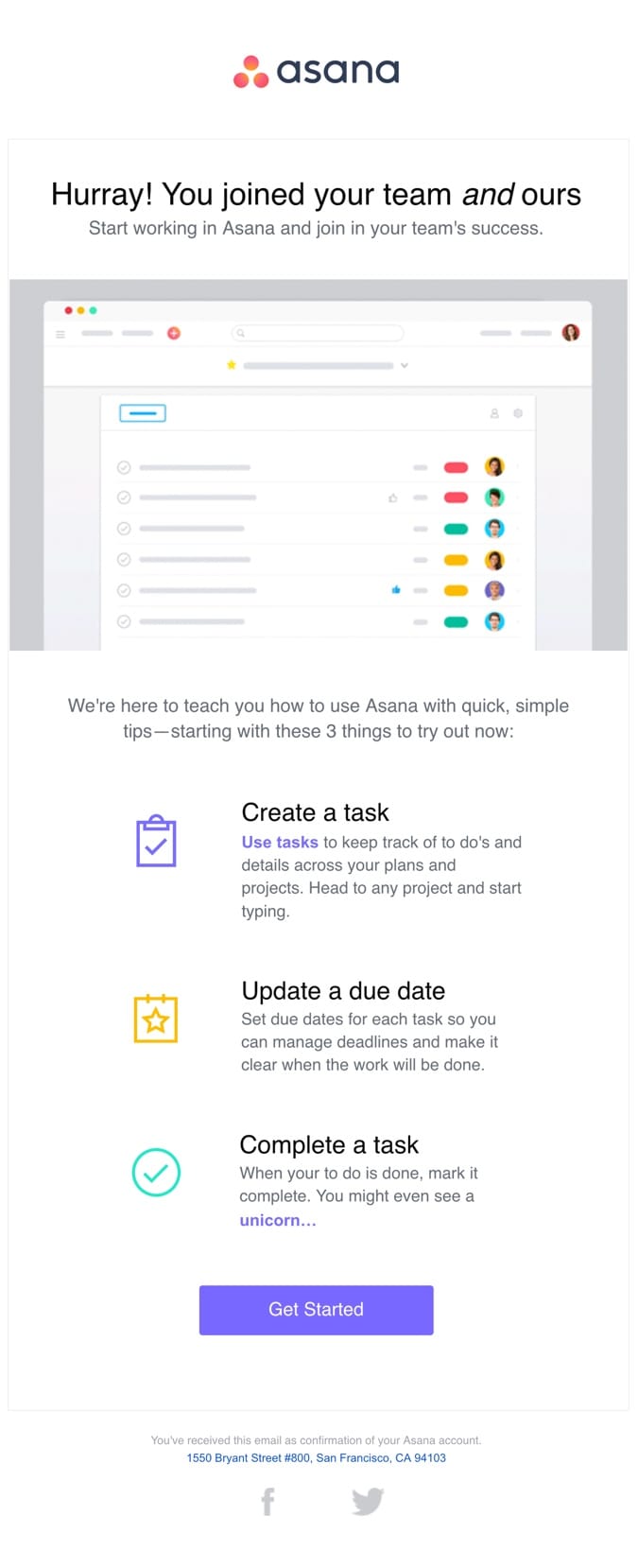
Notice how they say: “you joined your team and ours”?
This creates an instant connection between them and you. They then utilize The 1-2-3 Method by giving their new user three simple actions to take: Create a Task, Update a Due Date, and Complete a Task.
You should aim to do all this with as little writing as possible. Make your introduction quick, and ensure the three actions you encourage them to take are simple. Whether you choose to add images and color largely depends on your brand and industry.
For a brand like Asana it works. For many others a simple text email is enough.
The point is to introduce yourself and then give them clear instructions on what to do next.
Email 2: Acknowledge Them and Set Expectations
This next email should arrive shortly after the first (no later than one day, and no sooner than three hours). In the last email, you introduced yourself and gave them a few clear next-step instructions to take.
In this email, you turn attention to them in a bid to create engagement, whether by posing a question, providing a feedback form, or asking them to participate in a short survey.
The point here is to create a micro-commitment. If they take action or reply to your email at this stage, they’re more likely to open future emails and engage.
Just make sure you make it about them.
- What’s your biggest challenge right now?
- Why did you create a new account?
- What would help you the most over the next few weeks?
This email should also set any expectations for the journey ahead. James Clear does this well with one of his own welcome sequence emails:
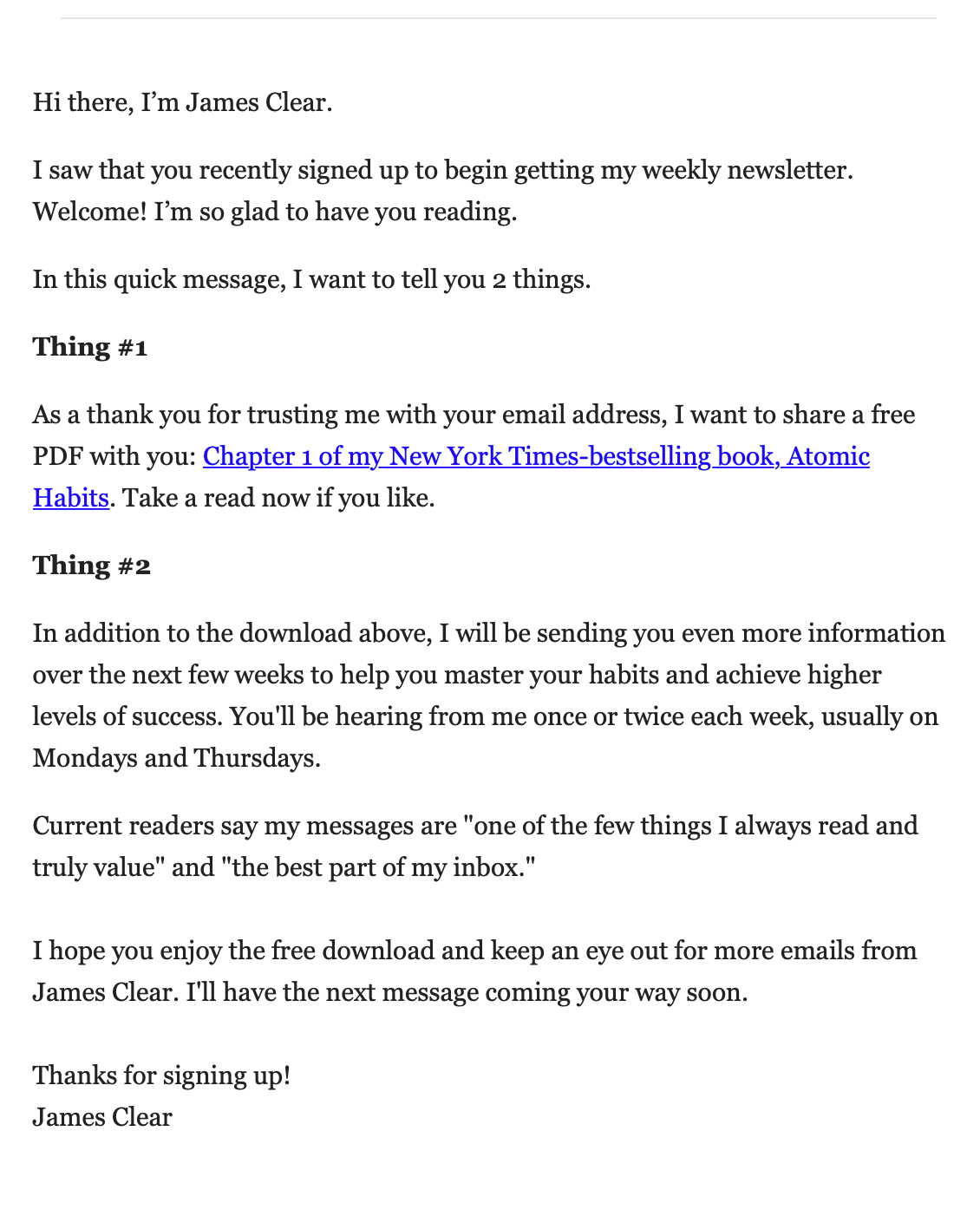
He prepares his readers for receiving one or two emails each week, even saying what days to expect them. He backs this up with some social proof regarding what his readers say about these emails.
This is the time to set the scene. If you’re about to take your reader on a journey, let them know what this journey involves.
Email 3: Share Your Best Content
You should send this third email within a few days of the last. This time you should focus on your best content that offers them the most value.
This could be:
- A blog post or article
- A featured interview on an authority site
- A training or video workshop (or recorded webinar)
- A podcast or video interview
This is also a good opportunity to share more of your story. Direct them to your About Page, or to a feature article that talks about your origins. At this stage, you should presume that they still don’t know much about you. Your story is one of your most valuable assets, so make sure they know about it.
Above all, provide value.
Don’t worry about giving away too much of it at this stage. Be generous and highlight some of the best content and resources you’ve created.
Although now is not the time to share in-depth guides or trainings that take up too much of their time.
Keep everything short and sweet.
Email 4: Soft Sell
A few days later you should test the waters with a soft sell email. Although many people won’t be ready to purchase at this stage, some will be. By not introducing them to this you could potentially lose a lot of new customers.
Of course, what your soft sell looks like depends on your product and industry.
- For an online coach, it may be a free 15-minute call…
- For a piece of software, it could be a 30-day free trial…
- For an online course, you may share the first module with them…
Another approach to this is asking them a question…
Here’s an example by James Scherer.
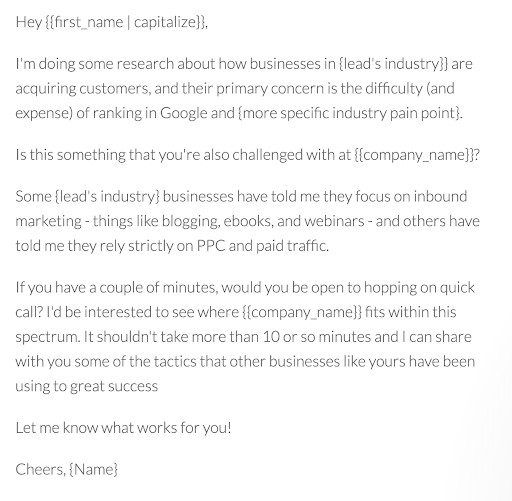
By framing it as “research” and simply asking a question about what they’re going through and what they need help with, you can gauge who needs help the most and how.
Once a conversation like this is started, you can direct them to your most relevant offer or arrange a call with them. A soft sell email is important to have because every person is on a unique journey, and some are farther along than others.
By providing a soft sell at this stage you transform those who need to take action now into paying customers. It also introduces everyone else to what you offer, giving them more context into what will come next.
Email 5: Invite Them to Take Action
This final email in your Welcome Sequence acts as a bridge between this stage and what comes next. It should come around 7 to 10 days after you sent your first, and invite them to take the next step with you.
Again, this next step largely depends on your business and product.
- It could be a hard sell on your product/service…
- It could be an invite to join a private Facebook group…
- It could be an invitation to follow you on social media…
- It could be filling out a survey or questionnaire…
The point with this email is to invite them to go deeper with you.
At this stage, you’ll begin to filter out those who are ready to engage with you versus everyone else. It’s not that you won’t continue to communicate with those who aren’t engaging, because there are other email sequence examples designed to get them on board.
Yet this email is for those ready to go deeper with you right now.
Give them a clear invitation of how they can do this.
Show them what this looks like and explain what they’ll get. Achieve this and you increase the likelihood they’ll engage with you long into the future.
Email Sequence Template 2: The Nurturing Sequence
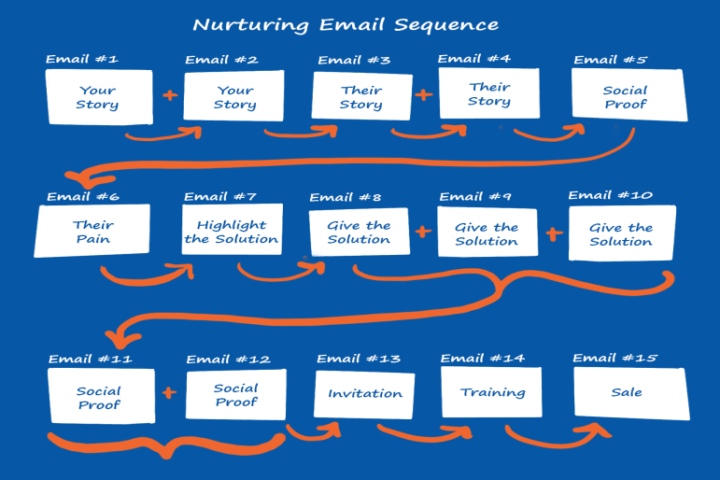
The Nurturing Sequence is for those who are already aware of you and your business. They may be an existing subscriber or customer, or simply someone who has gone through one of your Welcome Sequences.
They know of you, but they may feel like they still don‘t know you.
The purpose of this email sequence is to change this and build trust and rapport.
A nurturing sequence like this one can last anywhere from 14 days to 90 days or more. It’s often best used alongside other marketing like Facebook Ads and social media, as this creates a feeling that you’re everywhere and keeps you top of mind.
Through the nurturing email sequence, you build yourself up as an authority so people not only buy from you once but become an advocate of your brand.
These are the emails we recommend you include in your Nurturing Sequence:
Emails 1-2: Your Story + Your Mission
The first couple of emails you send should focus on you and your mission.
They should address questions like:
- What’s your vision for the future?
- Who do you serve and why do you serve them?
- What’s your origin story?
- Who is part of your team, and what is your culture?
These are the sort of questions you should answer, either by writing a long-form email that breaks down your story or an email that directs them to an About Page, feature article, or interview.
Video is a good route to take here also, as it allows you to share and show a lot in a single sitting.
Take this example from Patagonia.
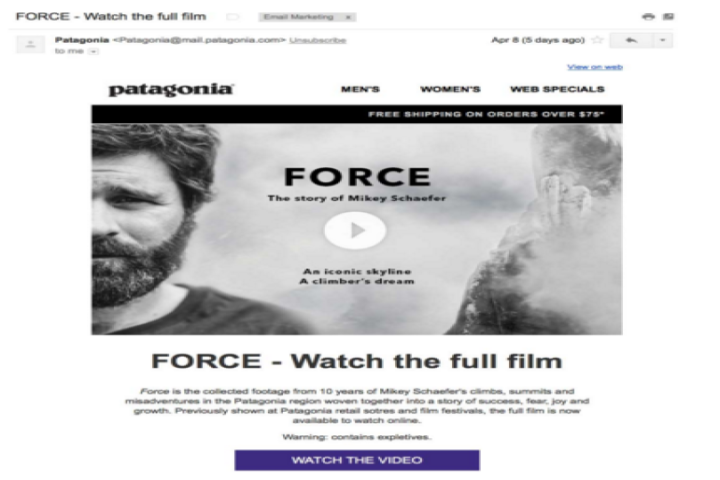
Although not a brand film, it’s a video that connects Patagonia with one of its customers. It shares a lot of its mission and story in a subtle and entertaining way.
This is the key to these first few emails – you need to talk about yourself without making it all about you.
Share your story, but invite them to be part of it.
Talk about your mission, but include them and your team.
Focus on your culture, but how it doesn’t center around you.
These first emails set the scene for what comes next and lays the foundation for trust and rapport.
Emails 3-5: Who They Are + Social Proof
These next few emails should turn attention toward the reader.
- Who are they?
- What’s their big problem?
- What’s their focus, story, and mission?
- Why are they here reading your emails?
The most important part of these emails is to create engagement. Ask questions. Create micro-commitments. Involve them and spark a conversation.
See how WWF does this…
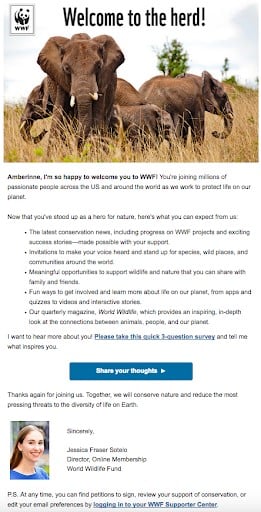
Not only do they “welcome you to the herd” but also invite you to share your thoughts via a short survey. They also include a quality headshot and personal details, which adds to the idea that you’re having a conversation with someone, instead of simply being spoken to by a company.
You’re still building trust at this stage, so less is more. A long questionnaire won’t help you.
But a short one might, as will simple questions that allow them to directly reply to you.
Finally, this is also the stage where you begin to share some social proof.
Help them feel like they’re not alone by sharing some testimonials.
Social proof not only breeds trust and rapport but improves the likelihood that they’ll engage and continue a conversation with you. There’s so much content these days that people are skeptical. Remove this barrier by adding some subtle social proof among these early emails.
Email 6: Illuminate Their Pain
At this stage, you’ve focused on your mission and story, and turned attention to who they are and the mission they’re on. The time has come to illuminate their pain and help them understand what it is.
How you do this depends on who your audience is, what industry you’re in and the product/service you offer. But everyone has pain. That’s the reason they’re in this email sequence.
The problem is, they may not be aware of having it or what it is.
You can frame this email and the next two using the BAB formula: Before – After – Bridge. In this first email, you illuminate their pain (Before). Focus on what their life is like now and the impact it has.
- Stress…
- Overwhelm…
- Feast or famine bank account…
- Not enough customers…
- Not enough time…
- Their health, fitness, or mindset…
You don’t need to go deep into their pain in this email. But highlight it. Help them see what it is. Shine a light on it so they’re aware of it, because unless they are they will never take action.
Email 7: Trigger Their Pain + Highlight The Solution
In this email, you focus on the “after” in the BAB formula.
The purpose is to show them what life could look like if they overcome their pain. However, to do this, you must first dive deeper into their pain and trigger it.
Inject some emotion into your copy and make them feel something: anger, frustration, fear, guilt, embarrassment.
This may sound strange, seeing as it’s in an email sequence designed to build trust and rapport. But you can only help them later if they know what’s holding them back now. Most people don’t fully understand the problem in front of them.
They need help feeling it.
That’s your job. Make them feel. And then… show them what life looks like on the other end. Paint a picture and hint at what the solution is.
Emails 8-10: Give Them The Solution
In the BAB formula, these emails focus on the “bridge”.
This is how they get from problem to solution, and it’s in these emails where you set yourself apart from everyone else and build immense trust.
Because instead of introducing them to your product or service, you generously give them the solution.
The solution can take many forms, including:
- The method.
- The framework.
- The process.
- The step-by-step plan.
Don’t worry about giving away too much. Most people can have all the information they need and still run into the same problems. The actual solution isn’t the content, but rather what to do with it. They’ll need your help to implement this, whether they appreciate it or not.
So right now, give them as much value as you can.
By doing so, you create trust and build long-lasting rapport.
You can do this through:
- Guides
- Modules from your course
- Live trainings and workshops
- Private webinars
- Video demos and walkthroughs
Give them as much as they can so they could go away and do it themselves. Although some people will try, the ones you want as a customer or client appreciate how ineffective and time consuming this is.
As such… these emails act as a great qualifier and help you find the perfect people to work with.
Emails 11-12: Social Proof + Testimonials
At this stage, they think you’re amazing because you’ve just given them a huge amount of value. They’ve been in your funnel for a few weeks, and you haven’t pushed one product after another onto them.
They’re beginning to trust you.
They feel like they can trust you.
Show them that they can by introducing them to people who already do.
Dive deep into social proof:
- Customer quotes and testimonials
- In-depth case studies
- Customer videos
- Links to interviews and featured press
It’s recommended that you share at least one in-depth piece at this stage. Whether it’s a case study, video success story or an interview with one of your customers… share a piece that goes deep.
The person in your funnel wants to see that you’re the real deal.
Show them that you are. Prove to them your process works.
Through an existing customer, map out the journey they’ve taken from pain to solution.
Email 13: Invitation
This email marks the beginning of the sales process.
But rather than jumping straight into a hard sell, set the scene by inviting them to be part of a training:
- A webinar
- A livestream
- A product run-through
Scott Oldford is a master at this, inviting people and setting the scene both through email and social media.
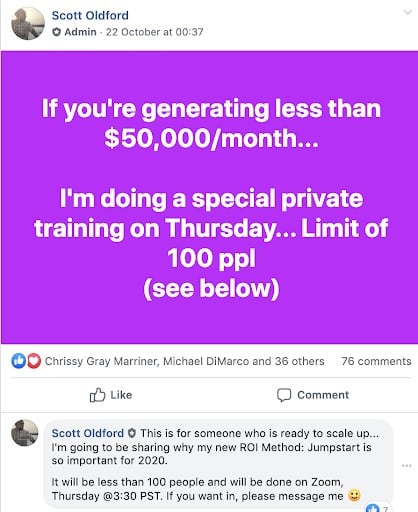
A short invitation can go a long way.
“[name], in a few days I’m releasing a training that covers [topic]. By attending this training you’ll get [list main benefits]. I wanted to give you a heads up that I’m running this… would you like an invitation to attend once it’s ready?”
An invitation email like this one offers a few key benefits:
- It sets the scene and prepares them for what comes next…
- It creates a micro-commitment (aka: they reply and say yes)…
- It provides an opportunity for a new conversation (when they reply, keep the chat going)…
Few people use emails like this in an email sequence. By using it, you instantly set yourself apart.
Email 14: Training
Following on from the last email, this is when you share the actual training with them.
The training you provide depends on your business:
- If you’re a coach, share a recording of an actual client call.
- If you have a software or tool, share a live demonstration on how to use it.
- If you sell a course, run a workshop where you go through a module in-depth.
This is when you can go in-depth and share something of true value. Don’t worry about length. It can be as long as it needs to be. This is the email that sets them up for what comes next… the sale!
Email 15: Sale / Launch
This email can become a separate email sequence in its own right.
Depending on what you’re selling, a single email may be enough or you may need to take them through an entire launch sequence.
At this stage, you’ve developed the trust you need to improve your conversations dramatically. So whatever route you decide to take with your sales, you’re sure to improve your conversations because your audience is ready to take action.
You’ve proven yourself to be unlike most “experts” they have come across.
You have taken the time to nurture them. The ROI of this is huge!
Email Sequence Template 3: The Onboarding Sequence
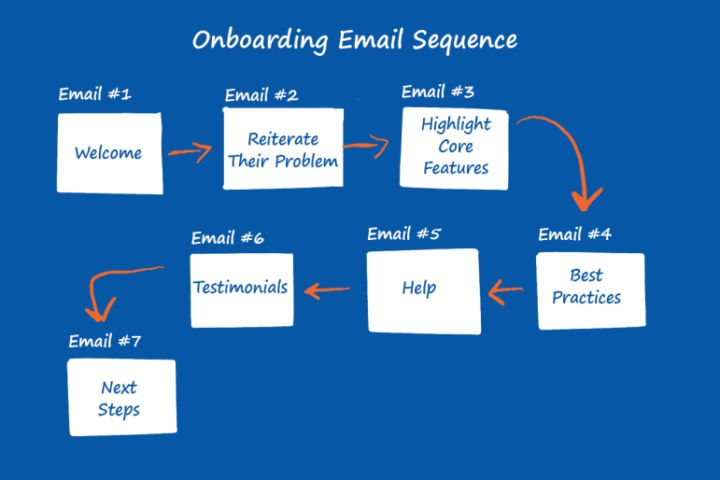
The Onboarding Sequence is for those who have just taken the leap into becoming a customer.
Depending on your product and business, some of these customers may know very little about you and your story.
For instance, if you sell a mobile app that costs $20, they may have purchased on the spot.
On the other hand, if you have a high-end program that costs $1,000, it’s safe to presume they have gone through your Welcome and Nurturing Sequences, and know and trust you.
Because of this, your Onboarding Email Sequence may need a few extra emails at the beginning that introduces your new customer to your story, mission, and best content and resources.
Either way, the purpose of the Onboarding Email Sequence is to set your new customer up for success.
- What do they need to know to get started?
- What are their next steps?
- What separates those who succeed versus those who don’t?
- What are the best practices they should follow?
- What can they expect in the coming days, weeks, and months?
Make sure your Onboarding Email Sequence lasts at least a week, that you guide them through the initial journey, and are there for them when they need you.
These are the emails we recommend you build your Onboarding Sequence around:
Email 1: Welcome + Activation
This first email is very similar to the one that starts The Welcome Sequence.
The 1-2-3 Method is once again a popular method to use, where you provide three simple actions for your new customer to take. Above all, your purpose here is to welcome them and assure them that they have made the right decision.
This email from Headspace is a good example of what it looks like.
A simple welcome and instructions on how to activate their account. There’s an option for those just getting started and one for those confident in meditation and what it involves.
Set the scene with a simple welcome, and give them the information that will help them the most.
Email 2: Reiterate Their Pain and Problem
Shortly after your welcome email, it’s important to remind them why they are here.
It’s time to reiterate their pain and problem.
- The reason they purchased from you…
- What their life is like right now…
- The impact it has on them…
- The solution ahead, if they do the work…
Unlike in the Nurturing Sequence, you don’t need to dive too deep here. They already know their pain, and understand it enough to have taken action. The purpose here is to remind them of this, so they’re ready to take the next steps with you that set them up for success.
To not just buy and then leave alone, but rather become your next big success story!
Email 3: Highlight Your Core Features and Benefits
They already bought from you, so you don’t need to sell them on your features once more.
However, it’s important to highlight your core features at this point: how they work and the main benefits that happen when they use them.
Too many brands focus on what their features are instead of the benefits these features produce. One of the rules of good copywriting is to highlight benefits ahead of features. One of the simplest ways to demonstrate this is through this classic iPod graphic.
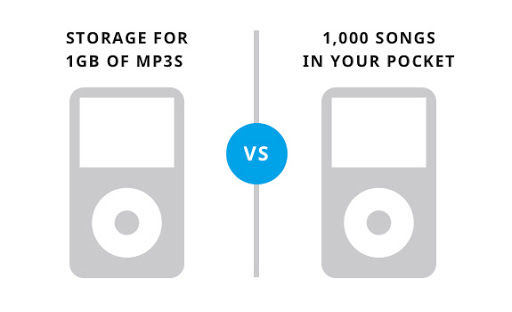
Few people care about how many gigabytes a device has. That doesn’t evoke any emotional attachment whatsoever. Whereas knowing what those gigabytes represent does.
Take this approach when onboarding your new customer.
Highlight the core features and explain what they are.
But more importantly… show them how they help them.
Amazon does this here:
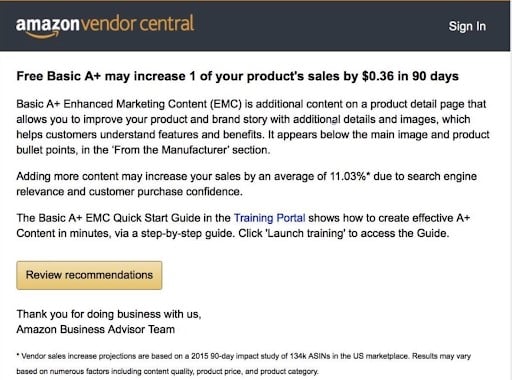
By focusing on the impact, results, and outcome, Amazon makes the need to know about the features unnecessary. If you want the results and benefits they talk about, the service on offer is relevant.
This perfectly sets up your next email where you show them HOW to use these core features.
Email 4: Best Practices + Case Studies
This comes back to setting your new customer up for success or letting them figure it out on their own.
Whatever your product or service, there’s often the right way to do it and the less effective way.
If your customer wants to achieve success, there are certain things they should do.
With this email, you explain what these Best Practices are (and how to use them).
However, rather than tell them about it, show them!
Through a customer case study, show them how it’s done.
You can do this through a video, interview, in-depth article, or whitepaper. Show them step-by-step the process they should follow to get the most out of you and your product or service.
Show them what a success story looks like.
And explain to them that by following these steps, they can have similar results and become your next big success story.
Email 5: Help / FAQ
With this email, you set out to answer any further questions your new customer may have.
This is often as simple as linking to an FAQ or support area on your site.
Although you can overview some of the more common questions in the email itself.
That said, don’t allow this opportunity for engagement to pass you by.
Encourage them to reply to your email and share their biggest question, worry, or problem. Give them the opportunity to skip the usual process of setting up a new support ticket or filling out a form.
As a new customer, let them speak to you directly. This helps create those memorable moments that stick with people for a long time and further enhances the trust you’ve already built.
Email 6: Testimonials
As you may have noticed by now, social proof plays an important role in these email sequence templates. The reason is that it’s one thing to say it yourself, and another for someone else to say it for you.
Potential and new customers alike want to see how other people have succeeded.
Give them access to this, and use it as a means to build a stronger rapport with your customers.
After all, many of your customers would appreciate you reaching out, asking them for a testimonial, and potentially interviewing them, sharing their story, and linking to their site.
The same applies here to previous emails that focus on social proof. Use a mix of:
- Customer quotes and testimonials.
- In-depth case studies.
- Customer videos.
- Past success stories.
It’s another opportunity to show, not tell.
Email 7: Next Steps
This marks the end of your Onboarding Email Sequence, but it likely doesn’t mark the end of your relationship with your customer.
Explain to them…
- What happens next…
- What they can continue to do for further success…
- What community they can join (a Facebook group, for instance)…
- How they can communicate with you moving forward…
- What you have in store for them in the coming months…
Be open and transparent with your customers. Overview what they get and what they don’t. If you treat these people correctly, they’ll likely be at the front of the line for your next product, launch, or promotion.
Show them what the next steps are, and keep the line of communication open.
Email Sequence Template 4: The Upsell Sequence
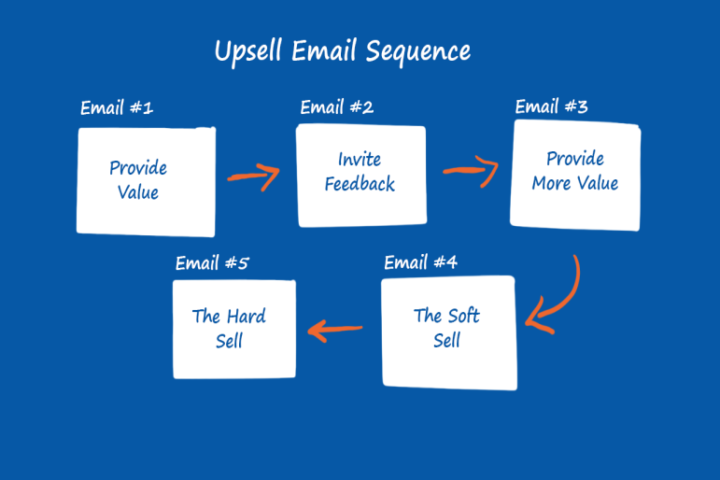
The Upsell Sequence is for those who have already become a customer and gone through your initial Onboarding Email Sequence.
Depending on your business, you may begin to upsell and cross-sell sooner than this.
An E-commerce business, for example, may begin upselling as soon as a purchase is made.
Amazon is a great example of this, as are most fashion outlets or those with a Shopify Store.
However, for the purposes of this email sequence example, we’ll assume this comes after your Onboarding Sequence. The purpose here is simple: entice your new customer to spend more money.
But it goes way beyond the money, because the Onboarding Sequence is also a great opportunity for you to provide further value to them, spark new conversations, and continue to nurture your relationship.
Most Upsell Sequences like this are short, taking place over a period of one week or less. Don’t overload them with options and keep selling to them for weeks on end. If you do, all that trust you’ve built will be lost (and it’s difficult to regain that).
These are the emails we recommend you build your Upsell Sequence around:
Email 1: Provide Value
This email is a chance to set the scene so you don’t simply jump into a new sale.
Give them something.
Be generous.
Provide value!
This could be a new feature to your product or service, a complimentary call, a whitepaper or guide, or a chance to join a private community (Facebook Group, Slack Channel, etc…).
Revisit their initial pain point and think about how you can best solve it now.
The value you provide doesn’t have to be in-depth. It’s the thought that counts.
It starts off your new email sequence with generosity at the forefront.
Email 2: Invite Feedback
This email turns the focus back to them and once more encourages engagement.
Ask for their opinion and to share their feedback of you and your product so far.
- A review
- A survey
- A feedback form
- A testimonial
Here’s a good example of this in action from Nest:
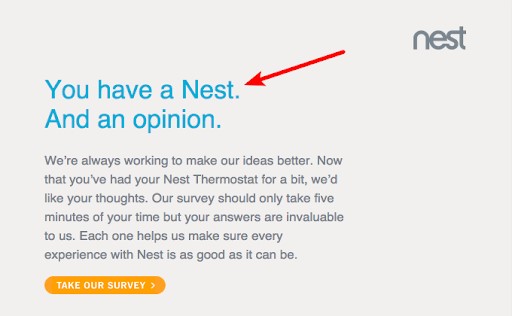
They acknowledge that you have had their product for a while so you may have an opinion. It’s a chance to share good feedback and bad, ask questions, and communicate directly with the brand.
They also remove the barrier of time by stating it only takes five minutes!
This is important. Presume your customer is low on time. Make it easy for them. Invite their feedback and an honest conversation, but assure them that this won’t take long.
Rather than them helping you, make it about them.
Email 3: Provide Further Value
This follows up on the first email and is another opportunity for you to provide value.
Again, this could come in the form of a resource or call, but also a discount, special offer, or voucher of some kind. You can also link this to the previous email where you asked for their feedback, and frame this as a thank you.
The purpose here is to once more make it about them and provide value.
This sets the foundation for what comes next, and the upsell and/or cross-sell.
Email 4: The Soft Sell
A few days later you should follow up on your last email where you provided value with a soft-sell email that introduces them to take a further step.
The same applies here as it did in The Welcome Sequence…
- You can invite them onto a free call…
- Share a free trial or discount…
- Ask them about something and frame it as research…
You can also link to one of your products by including it in a story or as part of a case study, subtly directing them toward the action you wish them to take.
Email 5: The Hard Sell
With this email, you go harder than the last and focus everything on the upsell and/or cross-sell.
This is easier for some businesses than others.
For instance, with an eCommerce brand like the Dollar Shave Club, it’s often a seamless transition.

It’s simply part of their messaging when reminding their customers of their next order.
For other businesses, this is not so seamless. For instance, if you’re a coach with a group program, your upsell might be to work one-on-one with you.
- There may be another tier to your program…
- or a live event/retreat they can sign up to…
- or a private group for existing clients only…
It’s less seamless and requires more thought, so be sure to build a story around WHY it’s important to upgrade and who it’s most beneficial for. Focus on the benefits, not just the added features.
Many people won’t need or want your upsell or cross-sell, but some will. It’s always easier to upgrade an existing customer than acquire someone new.
As such, an Upsell Email Sequence like this may end up being your most profitable in the long-term.
Email Sequence Template 5: The Re-Engagement Sequence
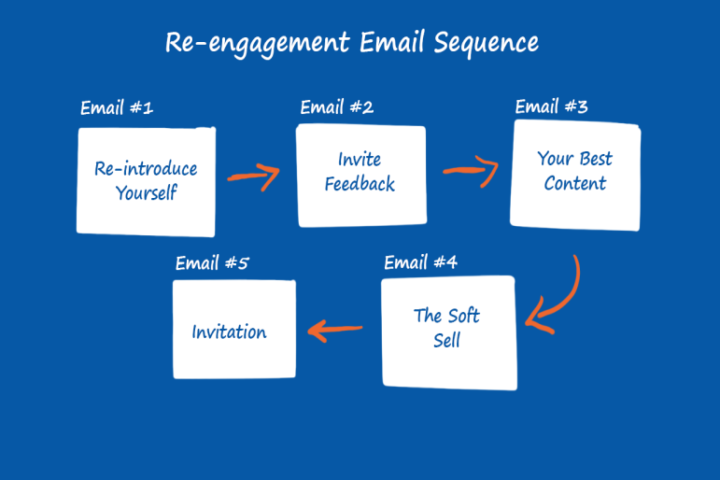
This final email sequence example is for those who have gone through your Nurturing Sequence but didn’t take the leap to become a customer.
- Maybe it wasn’t the right time…
- Maybe their pain wasn’t great enough…
- Maybe it wasn’t the right offer for them…
- Maybe they had other options…
The point is you don’t know why they didn’t pull the trigger. They have gone through your Nurturing Sequence and remained a subscriber, so there’s a good chance that they know you and trust you.
By staying top of mind and continuing to provide value, you’ll become their “go-to” solution when the time is right.
That’s the purpose of the Re-Engagement Sequence: to continue to show up and be top of mind.
Over time, this email sequence could become as long as your Nurturing Sequence (or longer).
To keep things simple, these are the emails we suggest you build your Re-Engagement Sequence on.
Email 1: Re-Introduce Yourself
It’s best to leave space before you add anyone into a re-engagement sequence like this one (at least 1 to 2 weeks). Don’t push them from one funnel to the next, as this is a sure way to lose all the trust you’ve built.
Once you do add them, dedicate your first email to re-introducing yourself:
- Share your story again.
- Focus on what your mission is.
- Turn attention to who you serve and why.
Make it about them and ask how they’ve been. Remind them of who you are, but also why they signed up to your list in the first place.
Be playful and not too serious. The last thing you want to do is create guilt.
Although like HireVue does in this example, you may like to force the issue:
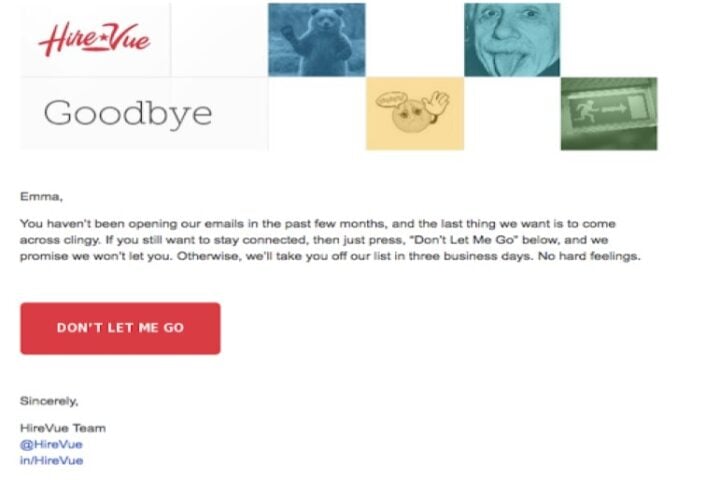
It’s amazing how powerful the fear of missing out can be (FOMO).
Once you make it clear that they will soon no longer hear from you, it’s often enough for them to spend a few minutes thinking about whether that’s a good thing or not.
It may surprise you how many people click that “Don’t Let Me Go” button for this reason.
Email 2: Invite Feedback + Engagement
A constant aspect of all of your email sequences is engagement.
Everyone has a busy inbox. You face an uphill battle to simply get noticed, let alone have your emails read and acted upon. The more you make it about them and invite them into the conversation, the better your chance of success.
If you want to re-engage an inactive subscriber, invite them to share feedback and engage.
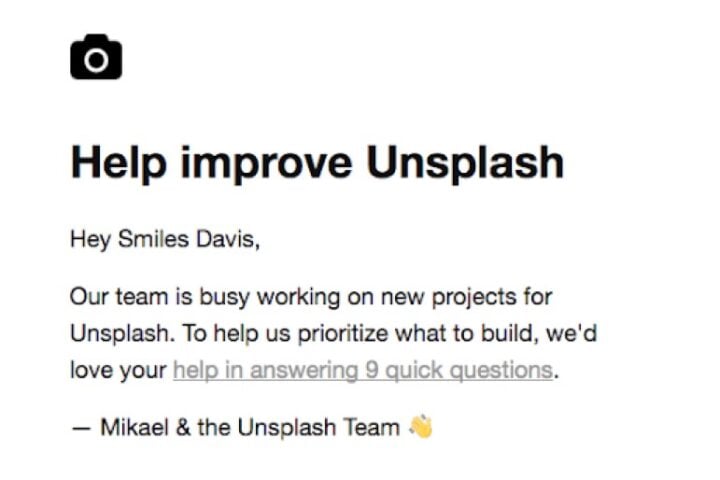
This simple call to action from Unsplash is a good example. It’s short, to the point and specific.
They want you to play a role in their new projects.
They’re keen to hear your feedback, specifically by answering 9 quick questions.
It starts a conversation and creates a micro-commitment.
Both of these are important elements when re-engaging a cold lead.
Email 3: Share Your Latest and Best Content
A couple of days later, remind them why they signed up for your updates in the first place.
They likely found you because of an article, press feature, interview, or social media post.
Turn attention back to your content and share the best you have to offer:
- A blog post or article.
- A featured interview on an authority site.
- A training or video workshop (or recorded webinar).
- A podcast or video interview.
But also share your latest content. Shift the focus to your current projects, most recent case studies, and the content that’s building the most traction now. They may have missed a lot of important updates, so make sure you let them know about these.
Share as much value as you can, and entice them to throw themselves back into the content that hooked them in the first place.
Email 4: Soft Sell
At this stage, it becomes very much like your Welcome Sequence where you test the water with a soft sell. Again, you have no idea why they didn’t take action last time around.
It might not have been that they didn’t need your product, but rather the timing wasn’t right.
Well, the timing may be right now. So re-introduce them to your offer in a subtle manner.
- It could be a short 15-minute phone call.
- A free trial to your software or tool.
- The first module from your course.
- A discount or special offer of some kind.
Or it may be a simple mention of your latest project, and an invitation to learn more…
Email 5: Invitation
The final email in your Re-Engagement Sequence is an invitation to take action.
- It could be information about your new product or service…
- It could be an invite to join your Facebook Group or Slack Channel…
- or it could simply be an invitation to keep getting these emails…
The purpose here is to engage them and keep the conversation going.
This could lead them back into your Nurturing Sequence or into a new Sales Funnel.
Over time you can keep adding to this Re-Engagement Sequence so it provides further value, introduces several upsell and cross-sell offers, and continues to keep you top of mind until the day arrives that they’re ready to take action.
These 5 email sequence templates all combine to ensure your audience is taken on a purposeful, memorable, and valuable journey. Used properly they help you stand out from all your competitors.
So, how can you use these email sequence templates inside your business?
Readly To Use These 5 Email Sequence Templates in Your Business?
These five email sequence templates lay the foundations to increase sales and build trust and rapport with your audience.
With this in mind, it’s time to consider which of these email sequences make sense for your business.
Begin by asking yourself which of these email sequences you need the most right now. If you don’t have any email sequences in place, a welcome sequence is the place to start. And if you already have a welcome sequence, you might consider adding an onboarding or nurturing sequence.
Then, after you decide which one you want to implement, you can get to work creating your winning email sequence!
Developing an effective email marketing strategy is no easy task. If you need some extra guidance on how to do email marketing effectively, download our Email Marketing Best Practices Checklist.